My Serious Affair With Semi-Dories
by Mike
Hillis
For the novice, semi-dories are
attractive, lightweight, easy-planing and fuel efficient little
craft. What’s not to love? John Gardner’s The
Dory Book includes plans for 4 semi-dories, 12 to
20 feet. I’ve built them all, or at least variations of
each. I’ve found each of them to be predictable, mannerly,
and fun little craft.
All of Gardner’s semi-dories
have narrow flat bottoms, and lapstrake, rounded sides, with a
flat run aft for planing. They’re all relatively narrow
meaning they plane with a small motor and are mannerly at all
speeds, i.e. they don’t have much of a transition between
displacement and planing speeds and best of all, they don’t
porpoise. Here’s a summary of each:

Photo #1, 12’ semi-dory
The Vacation-Cabin Boat-
My friends Gary and Cindy have a vacation home on Montana’s
Flathead Lake. They also have the ubiquitous 3000 pound, 200 hp
inboard-outboard ski boat, which incidentally has more horsepower
than either of my vehicles. They soon discovered that even though
Flathead Lake is 30 miles long, it didn’t take them much
time to explore the lake at 30 mph. They often found themselves
in the dilemma of trying to decide what to do after you’ve
circled the lake and it’s still not lunchtime! Worse, the
I-O was not comfortable at speeds of anything below a full plane,
because its nose was stuck skyward from about 6 mph to about 20
mph, while leaving a wake like an aircraft carrier. They asked
me for a “cute, wooden, putt-putt” type of boat. Photo
#1 is the 12’ Gardner semi-dory we selected. The boat is
built of 6mm Okoume on fir frames. It weighs ~120 lbs. It went
together with standard “glu-lap” construction. We
tried it out with my 5hp kicker, and it would plane with one person
and give an easy 7-8 mph with 2 persons aboard. Gary ultimately
powered it with a used 8hp. After one season, Gary and Cindy discovered
that the I-O was sitting idle most weekends, while the semi-dory
was in constant use. Their teenage sons, however, still needed
the adrenalin rush of the I-O. Kids! Photo #2 shows the boat with
my wife Lorena and dog Hannah. Lorena’s the one with the
cap.

Photo #2, The bow of the 12’ semi-dory
Troy’s Boat-
Troy is a social worker in Coeur d’ Alene, Idaho. He’s
seriously “boat-struck.” When we first got together,
Troy expressed his desires to own a 20’ baby tug, a 20'
cruising trailer-sailor, and a number of other fairly pricey boats.
Troy also had no real money. Actually, he only had ~$1000 to put
towards a boat. So, after much deliberation, we decided on a small,
car-toppable motorboat. We took Gardner’s 5-plank, 12’
semi-dory in Classic Craft You Can Build, “stretched”
it to 14’, substituted steam bent ribs for the sawn frames
from Gardner’s design, and added a foredeck and side decks.
I found Troy a 7.5hp Honda with low hours for $475. During construction,
I substituted cheap plywood forms for the sawn frames that Gardner
specified. I used temporary ribbands to establish the plank shapes.
After I pulled the boat off the molds I steam bent in ½”
x ¾” ash frames. Photos #3 and #4 show Troy and his
boat.
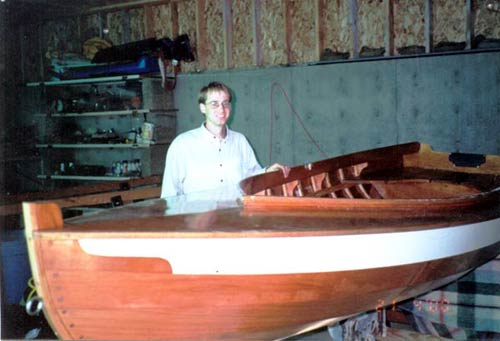
Photo #3, Troy and his 14’ semi-dory
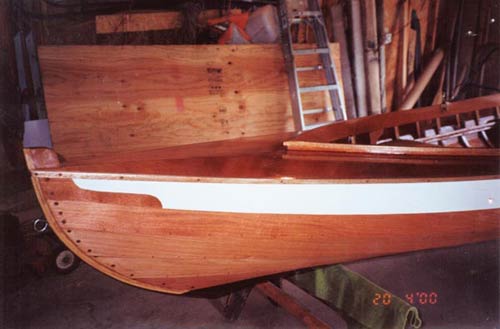
Photo #4, 14’ semi-dory, note the
steam-bent ribs and seat riser
The Big Boat-
The big boat was conceived while I was camp-cruising in a 16’
square-stern canoe along the southern coast of British Columbia.
I wanted to include my wife and dog on the next trip, and take
in Chatterbox Falls, and a few other similar destinations in south
coastal British Columbia. I selected Gardner’s 16’
semi-dory because it’s fairly cheap and easy to build, requires
low horsepower, and is very seaworthy for a 16’ boat. Check
out the height of the bow in construction photo #5!.
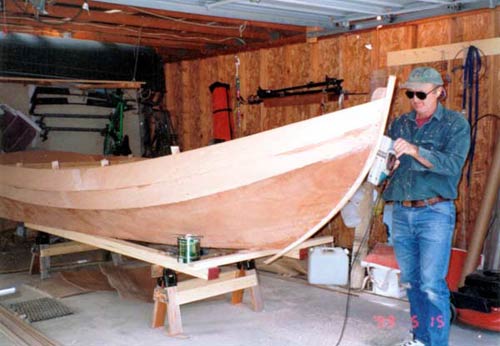
Photo #5, 16’ semi-dory under construction
We powered the boat with a 15 hp
Honda. It’s planes the boat at about 10 mph, even with two
adults and a dog, and a week’s worth of camping gear. Photo
#6 shows the boat in Narrows Inlet, B.C. The kicker on the bracket
is for emergency power only. The main engine sits in a tip-up
well, and is out of sight. Note the bent coaming at the bow. Chatterbox
Falls is at the end of a 30 mile-long Fiord. On the return trip
we hit 20-30 knot head winds, which collided with the outgoing
tide. We had 3-4’ steep, breaking seas for about 5 hours,
during which time we averaged only 4 mph. Eventually, the tide
changed, the seas became a lot less steep, and we were able to
complete the trip at 6-7 mph. Not bad for a 16’ boat. As
steep as the seas were we never really took green water over the
bow, although we did have to bail fairly constantly due to the
constant spray.
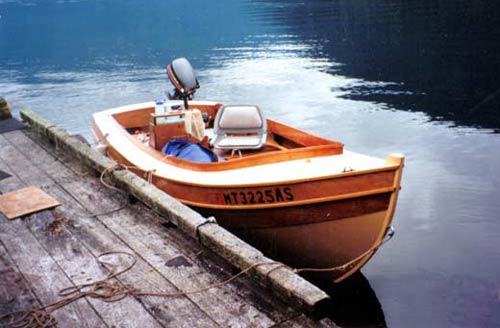
Photo #6, a very filthy and trip-weary 16’
semi-dory. (Note curved coaming)
Emma- You may
have seen Emma in a construction photo in DW last June, or in-the-water
photos last September. She’s basically a 19’8”
Gardner semi-dory with some serious modifications. Photo #7 illustrates
the original lines of Gardner’s boat (black) with my modifications
(red).
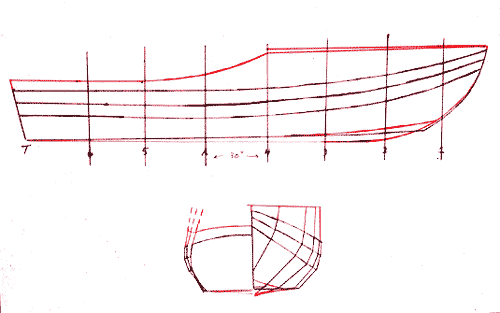
Photo #7, Emma’s lines, original Gardiner
lines (black) and my modifications (red)
The major changes include:
-
1) raising the chine (what
used to be the bottom) at the bow;
-
2) extending the stem aft
until it blends into the keel, which is 5” below the
old bottom line; and
-
3) running the keel straight
aft from station 3 to the transom;
-
4) adding a raised deck
forward; and
-
5) cutting out a portion
of the sheer strake to give it a broken sheer line.
Step #5 is trickier than it sounds.
To establish the true shape of the transom, you have to loft the
raised deck line as if there were no “cutout” (dashed
red line at the transom in the cross-section profile). The shape
of the cutout is established during construction suing battens
to make it eye-sweet.
Emma has a lot of carvings, samson
posts, wooden cleats, and other “cutesy” features.
Her main feature, however, is her performance. This is the perfect
“poor mans” yacht. She’s cheap to build, cheap
to power (15-20 hp), cheap to run (~12mpg), and cheap to trailer
(we tow her behind Asthma, our 14 year-old Trooper). Because of
her narrow beam and variable deadrise, there’s absolutely
no transition from displacement to planing speed. And, she’ll
handle big seas like boats substantially larger.
Incidentally, finding a trailer
for Emma was a little challenging. Trailers for 20’ boats
typically have capacity for 2000-4000 pounds. Emma only weighs
550 pounds, so with a typical trailer, the wheels would seldom
have touched the pavement! I ultimately special-ordered an EZ
Loader designed for a 14-17’ boat and had the tongue extended
2’.
I promised several DW readers that
I’d send out the Table of Offsets last winter. I’m
still procrastinating. During construction, I spent a couple weeks
of evenings lofting Emma. Yet, when I set up her frames on the
ladder frame, and bent ribbands around them, several were quite
unfair and took a lot of manipulating to get the hull sweet and
fair. Consequently, I’m a little nervous about sending out
offsets and having someone run into major construction problems.
Anyone familiar with lofting, and access to Gardner’s semi-dory
plans could build the boat assuming they understood lofting and
had a good eye. I’m debating re-lofting the boat and constructing/fairing
another hull in frame only using throw-away materials so I could
get full-size patterns for the molds, stem, and transom. Let me
know if you absolutely can’t live without the patterns,
and I’ll see what I can do. I’d probably need a few
bucks to offset the materials cost. Oh…… and I’d
be delighted to build one for somebody on the west coast!
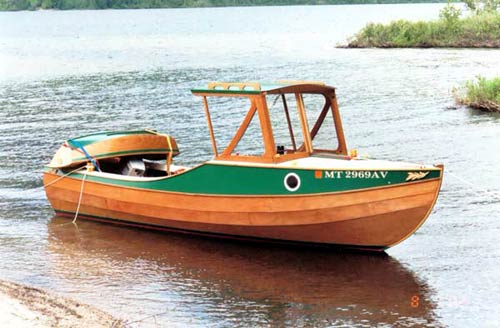
Photo #8, Emma at anchor with Cooter on
her stern
Photo #8 is a close-up of Emma.
Note our dinghy Cooter sitting upside down on the stern. Cooter
is a 6’x 4’, 33 lb Gartside-designed dinghy that my
wife built (with me hovering, annoyingly, at her elbow) as a tender
for Emma. Cooter also tows wonderfully! Emma has a self-draining
chain locker in the bow (which sits atop a floatation tank situated
between the stem and a bulkhead at station 1). Also note the walk-thru
windshield on the port side of the wheelhouse. The samson posts
are super-strong, and are the only feature that is overbuilt on
Emma. I tried to visualize being anchored in a strong headwind
and 4 foot chop for sustained periods. The motorwell is flanked
by watertight compartments and side-decks that makes it very strong,
but light (i.e. like an egg-carton). Spilled gasoline fumes drain
directly into the well, not into the cockpit.
Mike Hillis

|

